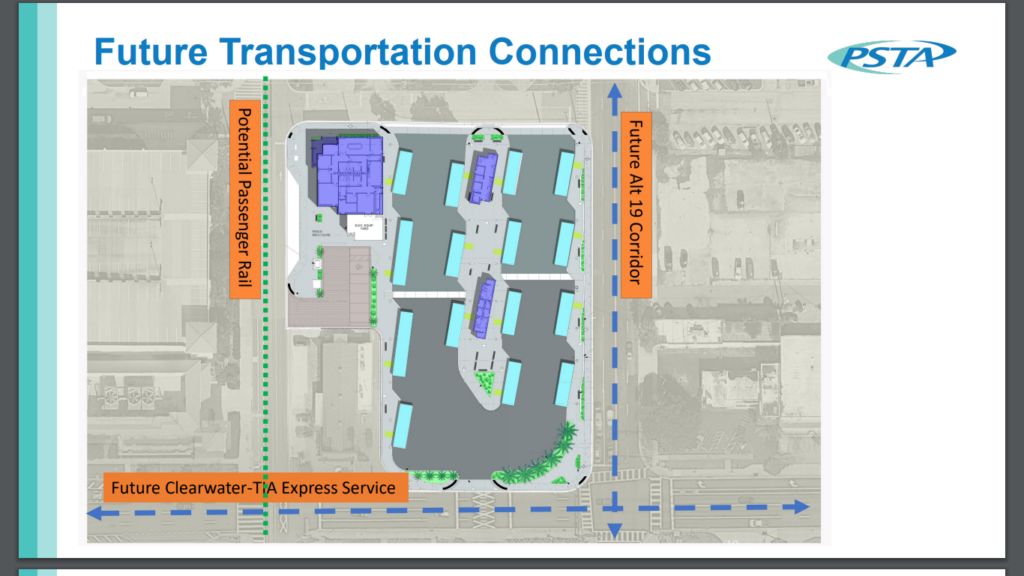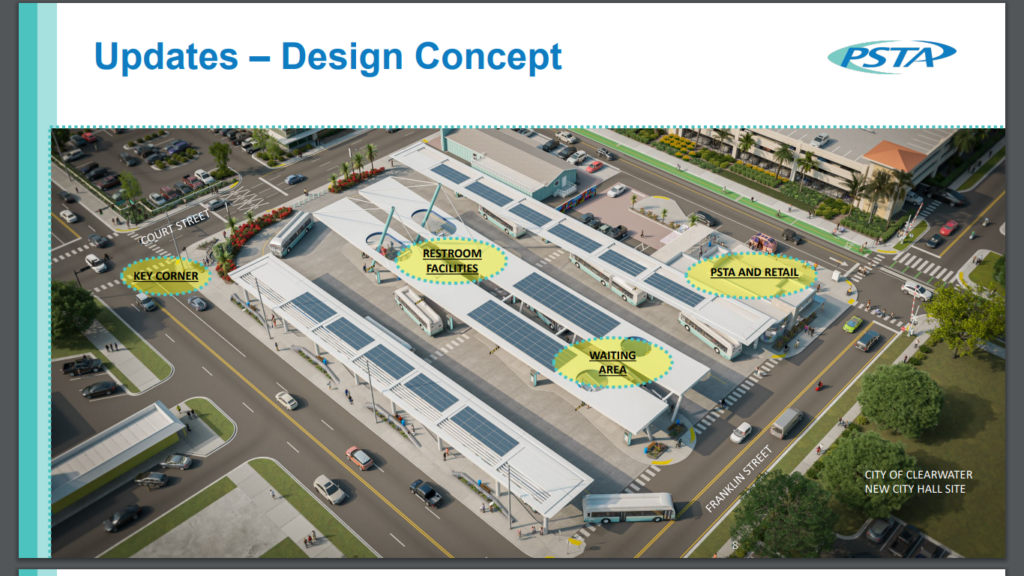Much-delayed PSTA Transit Center project moves forward

A decades-long initiative to build a modern multimodal transit center is moving forward as the Pinellas Suncoast Transit Authority recently traded properties with the City of Clearwater.
PSTA’s board celebrated the news during a March 27 project update. The $44.5 million Clearwater Multimodal Transit Center will accommodate 16 routes, double the Park Street Terminal’s capacity, and feature a solar panel array, electric bus charging stations, passenger rail and autonomous vehicle connectivity and retail space.
In October 2022, PSTA and Clearwater officials agreed to swap the outdated bus terminal site at 525 Park St. for a vacant city-owned lot at the corner of Court Street and Myrtle Avenue. An engineering firm subsequently found contaminated soil on both properties, further delaying the long-awaited deal.
“It’s incredibly exciting and truly historic that after nearly three decades of effort, this critical project for our customers is finally moving forward,” said board chair and St. Petersburg City Councilmember Gina Driscoll.

An overhead view highlights a potential passenger rail service (left), while another rendering features an autonomous vehicle picking up passengers. Screengrab.
Abishek Dayal, director of project management for PSTA, led the presentation. The transit agency built the Park Street Terminal in 1982, before current Americans with Disability Act (ADA) regulations.
Dayal said buses purchased after 2017 cannot clear the terminal’s awnings and must park outside the facility. “You can imagine when it’s pouring rain … it’s not a good experience for our riders,” he added.
In addition, the Park Street Terminal is well over capacity, its roof leaks and the building has significant structural issues. Maintenance costs have soared.
Alan Zimmet, general counsel for PSTA, said efforts to build a new terminal began in 1988. He recalled at least five previous unsuccessful relocation projects.
Zimmet said he was pessimistic that the latest initiative would come to fruition. Dayal said the City of Clearwater purchased the site at 710 Court Street in 2011 to accommodate a new facility.
However, funding remained an issue. That changed in August 2022 when PSTA received a $20 million U.S. Department of Transportation grant to build a new terminal.
Board member and Clearwater Councilmember David Albritton acknowledged the “long journey.” He said a former city manager wanted to move the site after stakeholders successfully secured project funding.
“He’s no longer with us,” Albritton said of the city manager. “So, I’m glad we’re finally at this stage. We’re moving along, and I look forward to having drawings this summer.”
The new transit center will receive Leadership in Energy and Environmental Design (LEED) certification for meeting sustainable design, construction and operations standards. It will also exceed ADA regulations.
Dayal expects more cyclists to utilize the terminal, as it abuts the Pinellas Trail. PSTA will build an enhanced bike storage facility.

A rendering highlighting the facility’s solar arrays, retail space and proximity to Clearwater’s new City Hall. Screengrab.
Upgraded waiting areas will feature real-time arrival and departure information. Rooftop solar panels will power electric vehicle charging stations.
The site plan includes retail space, unlike the current facility. Dayal said a small coffee shop could adjoin the primary entrance.
The transit center will provide dedicated rideshare and paratransit pickup and drop-off areas. Plans and renderings highlight it accommodating autonomous vehicles.
“I should also note that the City Hall project is going to be just north of us (the transit center),” Dayal said. He called the facility a “great way” for city employees to utilize PSTA’s services and increase public access.
Dayal said the project would enhance the intersection of Court Street and Myrtle Avenue through public art installations. “That’s the first thing people will see as they’re driving into downtown Clearwater …,” he added.
Dayal explained that PSTA officials are also exploring new transportation options, including an express service between Clearwater and Tampa International Airport. He said the adjacent CSX railroad tracks could accommodate a passenger rail line.
Dayal will recommend a design firm in the coming weeks. Project officials will request additional funding later this year, and he expects construction to commence in the summer of 2025.
“There’s a great future ahead,” Driscoll said. “I’m excited.”








JohnB
April 3, 2024at1:04 pm
Why is PSTA moving forward on anything? PSTA should not exist. [sentence moderated]
Why?
PSTA serves 1.5% of Pinellas residents; PSTA will spend $118 Million of taxpayers’ money this year.
Based on their estimates of 10 million “rides,” the cost will be almost $19/ride, riders will pay an average of $0.70/ride. Taxpayers pay $18.00!!
A “ride” is every time a bus is boarded, the majority of rides are round trips, to/from a destination. $36.
If a transfer is required, that means two rides to a destination, two rides back. In other words, it costs taxpayers $36 each way, $72 round trip.
Most Sunreunner rides are round trips, costing taxpayers $18 each way assuming the average rider pays $1/ride.
Solution: Give those who really need financial assistance an Uber/Lyft subsidy card, similar to an EBT card.
Benefit: taxpayers support only those who need financial assistance (make an EBT card the qualifier for the Uber/Lyft card). The user gets point-to-point transportation, much more quickly, less expensive than supporting buses with few or often no riders.
Did you know? Sunrunner is currently servicing about 900 actual riders per day. The capital cost of $50 Million (100% paid by taxpayers) and the operating costs (95% paid by taxpayers) are far more than justified for 900 riders.
Why do we allow this waste to continue? It is all about taking our money and redistributing it to salaries ($46 Million in 2024), contractors who build bus stops and “transit centers” (this one is $45 Million, all taxpayers’ money), bus manufacturers (over $1 Million each, 20 new ones recently ordered, all taxpayers’ money).
WHEN DOES IT STOP? WHEN TAXPAYERS WAKE UP AND SAY NO MORE!
SEND AN EMAIL TO THE PSTA BOARD: Gina Driscoll, gi***********@****te.org is the current chair.
https://www.psta.net/about-psta/board-of-directors/
Pedro
April 2, 2024at5:21 pm
Please give us more info on the CSX railroad being turned into commuter rail.